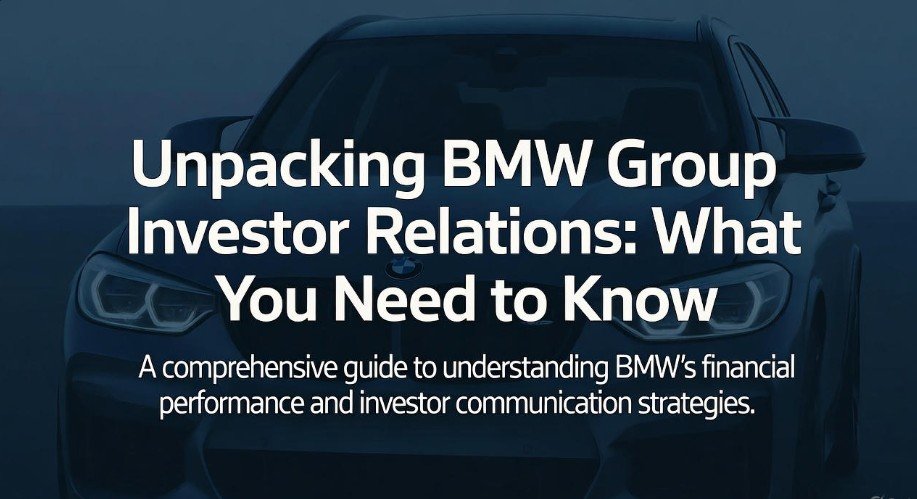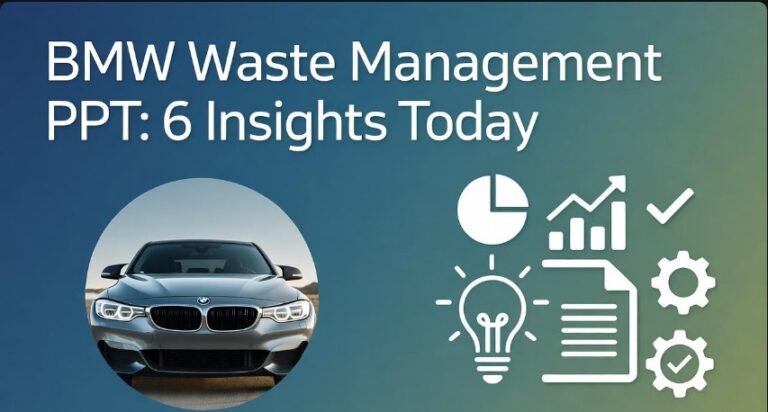BMW Group Investor Relations: 5 Key Facts

BMW Group Investor Relations: 5 Key Facts Every Investor Must Know
Key Takeaways
- Understand BMW’s financial health with key figures.
- Discover BMW’s strategic growth initiatives.
- Learn about BMW’s commitment to sustainability.
- Identify BMW’s dividend policy and shareholder returns.
- Navigate BMW’s investor relations website effectively.
Investing in the automotive industry can be exciting, especially when it involves iconic brands. The BMW Group, a name synonymous with luxury, performance, and innovation, offers a compelling investment opportunity. However, before you put your hard-earned money to work, it’s crucial to understand the company’s financial standing, strategic direction, and commitment to its shareholders. Navigating the world of corporate finance might seem daunting, but we’re here to simplify it for you. This guide will break down the essential facts about BMW Group investor relations, making it easy for you to make informed decisions.
Unpacking BMW Group Investor Relations: What You Need to Know

The BMW Group operates on a global scale, producing and selling vehicles under various premium brands. For potential investors, understanding how the company communicates its performance and future plans is paramount. BMW’s investor relations department serves as the crucial link between the company and its shareholders, analysts, and the broader financial community. They are responsible for transparently disseminating financial results, strategic objectives, and key corporate developments. This section will delve into why this relationship is so vital for anyone considering an investment in the BMW Group.
Fact 1: Understanding BMW’s Financial Performance and Reporting

The bedrock of any investment decision lies in a company’s financial health. For the BMW Group, this means scrutinizing its revenue streams, profitability, and overall financial stability. Investor relations plays a key role in making this information accessible and understandable to the public. They publish quarterly and annual reports, detailing key financial metrics that offer insights into the company’s performance.
When you explore BMW’s investor relations portal, you’ll typically find standardized financial statements like the income statement, balance sheet, and cash flow statement. These documents are essential for grasping the company’s operational efficiency and financial position. For instance, revenue figures indicate how much money the company is making, while net profit shows its actual earnings after all expenses. Understanding these numbers helps you assess the company’s ability to generate returns for its investors.
One of the most closely watched metrics in the automotive industry is the Automotive Segment EBIT Margin. This figure represents the earnings before interest and taxes as a percentage of revenue generated from the automotive segment. A healthy and stable or growing EBIT margin suggests that BMW is efficiently managing its costs and operations within its core business. Fluctuations in this margin can signal industry challenges, increased competition, or changes in production costs.
Another critical aspect is the Free Cash Flow (FCF). Positive and growing FCF indicates that the company generates more cash than it needs to cover its operating expenses and capital expenditures. This cash can then be used for reinvestment, debt reduction, or distributed to shareholders through dividends or share buybacks. Investor relations will highlight trends in BMW’s FCF to demonstrate its financial strength and flexibility.
Here’s a look at some key financial indicators you might encounter:
| Key Financial Indicator | Description |
|---|---|
| Revenue | Total income generated from the sale of vehicles and other business activities. |
| Automotive Segment EBIT Margin | Profitability of the core automotive business before interest and taxes, as a percentage of automotive revenue. |
| Net Profit | The company’s profit after all expenses, taxes, and interest have been deducted. |
| Free Cash Flow (FCF) | Cash generated by operations minus capital expenditures, representing cash available for other uses. |
| Earnings Per Share (EPS) | A company’s net profit divided by the number of outstanding shares, indicating profitability per share. |
For detailed financial reports, the BMW Group’s official investor relations website is the primary source. These reports are often downloadable in PDF format, allowing for in-depth analysis. Familiarizing yourself with these documents is your first step towards understanding BMW’s financial narrative.
Fact 2: Strategic Vision and Future Growth Drivers for BMW
Beyond current financial performance, investors are keen to understand a company’s strategy for future growth and its long-term vision. The BMW Group is at the forefront of significant transformations within the automotive industry, driven by electrification, digitalization, and sustainability. Investor relations departments are tasked with clearly articulating these strategies to the investment community.
A core element of BMW’s strategy is its commitment to electromobility. The company is investing heavily in developing and launching a range of all-electric vehicles (EVs) across its brands, including the BMW i series and MINI Electric. Investor relations will provide updates on sales figures for EVs, production capacity, and the development of battery technology and charging infrastructure. Understanding the pace and success of this transition is crucial for assessing BMW’s future competitiveness.
Digitalization is another key pillar. This includes advancements in in-car connectivity, autonomous driving technologies, and digital customer experiences throughout the sales and ownership journey. BMW’s investor relations will often highlight investments in software development, partnerships with tech companies, and the rollout of new digital services. These efforts are aimed at enhancing customer value and creating new revenue streams.
The concept of the “i” division, which often refers to BMW’s future-oriented technologies and services, is a significant part of their strategic communication. This can encompass everything from advanced driver-assistance systems to new mobility solutions. Keeping an eye on announcements related to the “i” strategy provides insight into where BMW sees its innovation heading.
Furthermore, BMW is focused on resource efficiency and circular economy principles. This extends beyond just powertrains to include sustainable materials in vehicle production, reducing emissions in manufacturing processes, and designing vehicles for easier recycling. Investor relations will communicate the company’s progress towards its sustainability goals, which are increasingly important for attracting environmentally conscious investors and meeting regulatory requirements.
To understand these future growth drivers, investor relations often publishes:
- Annual reports with detailed strategy sections.
- Presentations from investor conferences and roadshows.
- Press releases announcing new product launches, technological advancements, and strategic partnerships.
- Dedicated sections on their website focusing on technology and future mobility.
The strength of BMW’s strategic execution will directly impact its ability to maintain its premium positioning and profitability in a rapidly evolving automotive landscape. By following these communications, you can gauge the company’s preparedness for the future.
Fact 3: Commitment to Sustainability and ESG Factors

In today’s investment climate, environmental, social, and governance (ESG) factors are no longer secondary considerations; they are integral to assessing a company’s long-term viability and ethical standing. The BMW Group has placed a strong emphasis on sustainability, and its investor relations team is responsible for communicating these efforts comprehensively. This includes environmental protection, social responsibility, and robust corporate governance.
Environmentally, BMW is focused on reducing its carbon footprint across the entire value chain. This involves not only the emissions from its vehicles (particularly through electrification) but also the energy consumption and emissions from its production plants. They will report on targets for CO2 reduction, the use of renewable energy in manufacturing, and efforts to improve resource efficiency and reduce waste. For instance, reports might detail the percentage of renewable energy used in their factories or the progress made in reducing water consumption.
Socially, BMW’s commitment extends to its employees, supply chains, and the communities in which it operates. This can include initiatives related to employee diversity and inclusion, fair labor practices in its supply chain, and corporate social responsibility programs. Investor relations will highlight how the company fosters responsible labor conditions and contributes positively to society. Information on employee training programs, diversity statistics, and community engagement projects can often be found.
On the governance front, BMW emphasizes ethical business practices, transparency, and accountability. This involves the structure of its board of directors, executive compensation policies, and measures to prevent corruption and ensure compliance with regulations. Strong governance is seen as a key indicator of a well-managed and trustworthy company. Investor relations provides details on board composition, corporate governance guidelines, and compliance efforts.
The BMW Group often publishes a dedicated Sustainability Report, which is a crucial document for understanding their ESG performance. This report usually follows international reporting standards, such as the Global Reporting Initiative (GRI). It offers detailed data and qualitative descriptions of their sustainability activities and targets.
Key areas of focus in BMW’s sustainability efforts include:
- Decarbonization: Reducing greenhouse gas emissions in production and vehicle use.
- Circular Economy: Maximizing the use of recycled materials and designing for recyclability.
- Supply Chain Responsibility: Ensuring ethical and sustainable practices among suppliers.
- Social Commitment: Promoting diversity, fair labor, and community engagement.
- Transparent Governance: Upholding high standards of corporate conduct and oversight.
For investors, a strong ESG profile can indicate reduced risk, enhanced brand reputation, and a greater likelihood of long-term success, especially as regulatory and consumer pressures around sustainability continue to grow. External organizations like the U.S. Securities and Exchange Commission (SEC) provide regulatory frameworks that often encourage or mandate ESG reporting, making this information more standardized and accessible.
Fact 4: Dividend Policy and Shareholder Returns
For many investors, the prospect of receiving a return on their investment through dividends is a significant factor. The BMW Group has a history of distributing profits to its shareholders, and its dividend policy is a key piece of information communicated through its investor relations channels.
The BMW Group typically proposes an annual dividend based on its financial performance in the preceding fiscal year. The amount of the dividend is often linked to the net profit of the company. Investor relations will announce the proposed dividend at the time of the annual financial results, subject to approval by the shareholders at the Annual General Meeting (AGM). Understanding the dividend per share and the dividend yield (the annual dividend per share divided by the stock’s market price) helps investors assess the income component of their potential returns.
The consistency and growth of BMW’s dividend payments are often seen as indicators of the company’s financial stability and confidence in its future earnings potential. While dividends are not guaranteed and can fluctuate based on economic conditions and company performance, a track record of stable or increasing dividends is generally viewed favorably by income-focused investors.
Here’s what you should look for regarding shareholder returns:
- Dividend Per Share: The amount of dividend paid for each outstanding share.
- Dividend Payout Ratio: The percentage of net earnings that is paid out as dividends. A sustainable payout ratio is crucial.
- Dividend Yield: The annual dividend per share divided by the current stock price, expressed as a percentage.
- Share Buybacks: Besides dividends, companies may also return capital to shareholders through share repurchase programs, which can increase the value of remaining outstanding shares.
When you visit the BMW Group’s investor relations website, look for a section dedicated to “Shareholder Returns” or “Dividends.” Here, you will typically find historical dividend data, information on payment dates, and any announcements regarding dividend proposals. This information is vital for investors seeking income from their investments.
Additionally, understanding the tax implications of dividends in your specific jurisdiction is important. For U.S. investors, dividend taxation rules can be complex, and consulting with a financial advisor is recommended. Resources from organizations like the Internal Revenue Service (IRS) can offer guidance on dividend taxation.
BMW’s approach to shareholder returns reflects its commitment to providing value not just through potential stock appreciation but also through direct income distributions, making it an attractive proposition for a broad range of investors.
Fact 5: Navigating the BMW Group Investor Relations Website and Resources
The BMW Group’s investor relations website is your central hub for all essential information. It’s designed to be a comprehensive resource for shareholders, analysts, and anyone interested in the company’s financial performance and corporate strategy. Mastering how to navigate this site will significantly enhance your ability to stay informed.
Typically, you’ll find the investor relations section prominently featured on the BMW Group’s main corporate website. Once there, organized sections will guide you through various types of information. These usually include:
- Financial Calendar: This outlines key dates for financial reporting, such as quarterly earnings releases, investor conferences, and the Annual General Meeting.
- Financial Publications: Access to annual reports, interim reports, press releases, and presentations. These are the primary sources for detailed financial data and strategic insights.
- Share Information: Details about the company’s stock, including its ticker symbol, stock performance charts, and links to stock exchange information.
- Corporate Governance: Information on the company’s board of directors, management structure, and governance principles.
- Sustainability: Dedicated pages or reports detailing the company’s ESG efforts and targets.
- Contact Information: Details for reaching out to the investor relations team directly with specific questions.
Many investor relations websites also offer an “Email Alerts” or “Subscribe” feature. By signing up, you can have important updates, such as earnings announcements and press releases, delivered directly to your inbox. This proactive approach helps you stay current without constantly having to check the website.
When reviewing financial reports, such as an Annual Report, pay attention to the Management Report section. This is where the company’s leadership discusses the business environment, performance, strategy, and future outlook. It provides valuable qualitative context to the quantitative financial data.
For those new to financial analysis, BMW’s investor relations team often provides investor-specific webcasts or presentations that break down complex financial information into more digestible formats. These can be excellent starting points for understanding the company’s performance and strategy.
Pro Tip:
Bookmark the BMW Group investor relations website and sign up for email alerts to ensure you never miss critical financial updates or strategic announcements. Regularly reviewing these communications is key to staying informed as an investor.
Effectively utilizing the BMW Group’s investor relations resources empowers you to make well-informed decisions and track the company’s progress over time. It’s about building a clear picture of the company’s current state and its trajectory for the future.
Frequently Asked Questions (FAQ) about BMW Group Investor Relations
Q1: What is the primary goal of BMW Group Investor Relations?
A1: The primary goal of BMW Group Investor Relations is to ensure transparent and timely communication with the financial community, including shareholders, analysts, and potential investors. They aim to provide accurate information about the company’s financial performance, strategy, and outlook.
Q2: Where can I find the BMW Group’s latest financial results?
A2: You can find the latest financial results, including quarterly and annual reports, on the official BMW Group investor relations website. These reports are usually published in the “Financial Publications” or “Reports” section.
Q3: How does BMW Group communicate its sustainability efforts to investors?
A3: BMW Group communicates its sustainability efforts through its dedicated Sustainability Report, sections on its investor relations website, and integrated reporting within its annual reports. They highlight progress on environmental, social, and governance (ESG) targets.
Q4: What is the BMW Group’s dividend policy?
A4: The BMW Group typically proposes an annual dividend based on its financial performance, with the amount subject to shareholder approval. Details on dividend history, proposals, and payment dates are available on their investor relations website.
Q5: How can I contact the BMW Group investor relations team?
A5: Contact information for the BMW Group investor relations team, including email addresses and phone numbers, is usually listed in the “Contact” section of their investor relations website. This is the best way to direct specific inquiries.
Q6: Does BMW Group offer investor webcasts or presentations?
A6: Yes, BMW Group often provides webcasts and presentations for its financial results and investor events. These are typically made available on demand on their investor relations website for those who cannot attend live.
Conclusion: Building Confidence Through Informed Investment in BMW Group
Exploring BMW Group investor relations might seem like a deep dive into corporate finance, but understanding these five key facts provides a solid foundation for any investor. From dissecting financial reports to appreciating the company’s forward-looking strategy in electromobility and sustainability, and considering shareholder returns, the BMW Group offers a transparent and accessible investment opportunity. The investor relations department acts as your guide, providing the necessary tools and information to make informed decisions. By regularly engaging with their resources, you can confidently track the company’s journey and assess its potential as a valuable addition to your investment portfolio.





